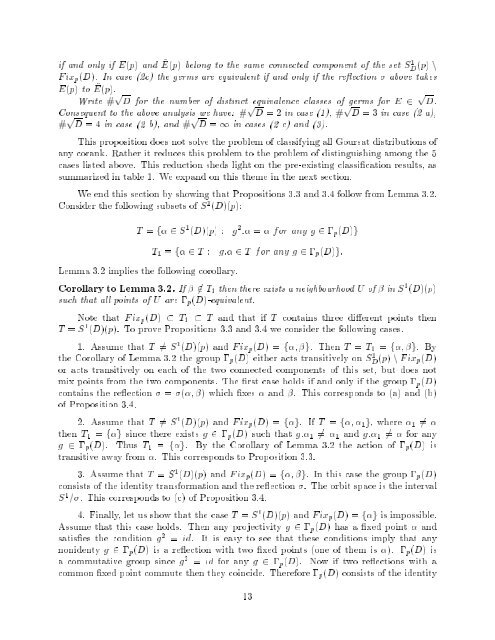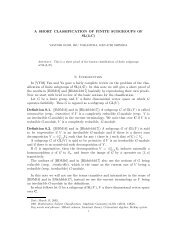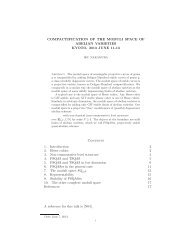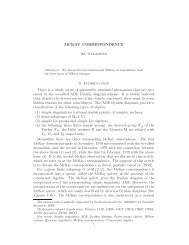GEOMETRIC APPROACH TO GOURSAT FLAGS * Richard ...
GEOMETRIC APPROACH TO GOURSAT FLAGS * Richard ...
GEOMETRIC APPROACH TO GOURSAT FLAGS * Richard ...
- No tags were found...
Create successful ePaper yourself
Turn your PDF publications into a flip-book with our unique Google optimized e-Paper software.
if and only if E(p) and ~ E(p) belong to the same connected component of the set S 1 D (p) nFix p (D). Incase (2c) the germs are equivalent if and only if the reection above takesE(p) to ~ E(p).Write # p D for the number of distinct equivalence classes of germs for E 2 p D.Consequent to the above analysis we have: # p D =2in case (1), # p D =3in case (2 a),# p D =4in case (2 b), and # p D = 1 in cases (2 c) and (3).This proposition does not solve the problem of classifying all Goursat distributions ofany corank. Rather it reduces this problem to the problem of distinguishing among the 5cases listed above. This reduction sheds light onthe pre-existing classication results, assummarized in table 1. We expand on this theme in the next section.We end this section by showing that Propositions 3.3 and 3.4 follow from Lemma 3.2.Consider the following subsets of S 1 (D)(p):T = f 2 S 1 (D)(p) :g 2 : = forany g 2 ; p (D)gT 1 = f 2 T :g: 2 Tforany g 2 ; p (D)g:Lemma 3.2 implies the following corollary.Corollary to Lemma 3.2. If 62 T 1 then there existsaneighbourhood U of in S 1 (D)(p)such that all points of U are ; p (D)-equivalent.Note that Fix p (D) T 1 T and that if T contains three dierent points thenT = S 1 (D)(p). To prove Propositions 3.3 and 3.4 we consider the following cases.1. Assume that T 6= S 1 (D)(p) and Fix p (D) =f g. Then T = T 1 = f g. Bythe Corollary of Lemma 3.2 the group ; p (D) either acts transitively on S 1 D (p) n Fix p(D)or acts transitively on each ofthe two connected components of this set, but does notmix points from the two components. The rst case holds if and only if the group ; p (D)contains the reection = ( ) whichxes and . This corresponds to (a) and (b)of Proposition 3.4.2. Assume that T 6= S 1 (D)(p) and Fix p (D) =fg. If T = f 1 g where 1 6= then T 1 = fg since there exists g 2 ; p (D) such that g: 1 6= 1 and g: 1 6= for anyg 2 ; p (D). Thus T 1 = fg. By the Corollary of Lemma 3.2 the action of ; p (D) istransitive away from. This corresponds to Proposition 3.3.3. Assume that T = S 1 (D)(p) and Fix p (D) =f g. Inthis case the group ; p (D)consists of the identity transformation and the reection . Theorbit space is the intervalS 1 =. This corresponds to (c) of Proposition 3.4.4. Finally, let us show that the case T = S 1 (D)(p) and Fix p (D) =fg is impossible.Assume that this case holds. Then any projectivity g 2 ; p (D) has a xed point andsatises the condition g 2 = id. It is easy to see that these conditions imply that anynonidenty g 2 ; p (D) isareection with two xed points (one of them is ). ; p (D) isa commutative group since g 2 = id for any g 2 ; p (D). Now iftwo reections with acommon xed point commute then they coincide. Therefore ; p (D) consists of the identity13





